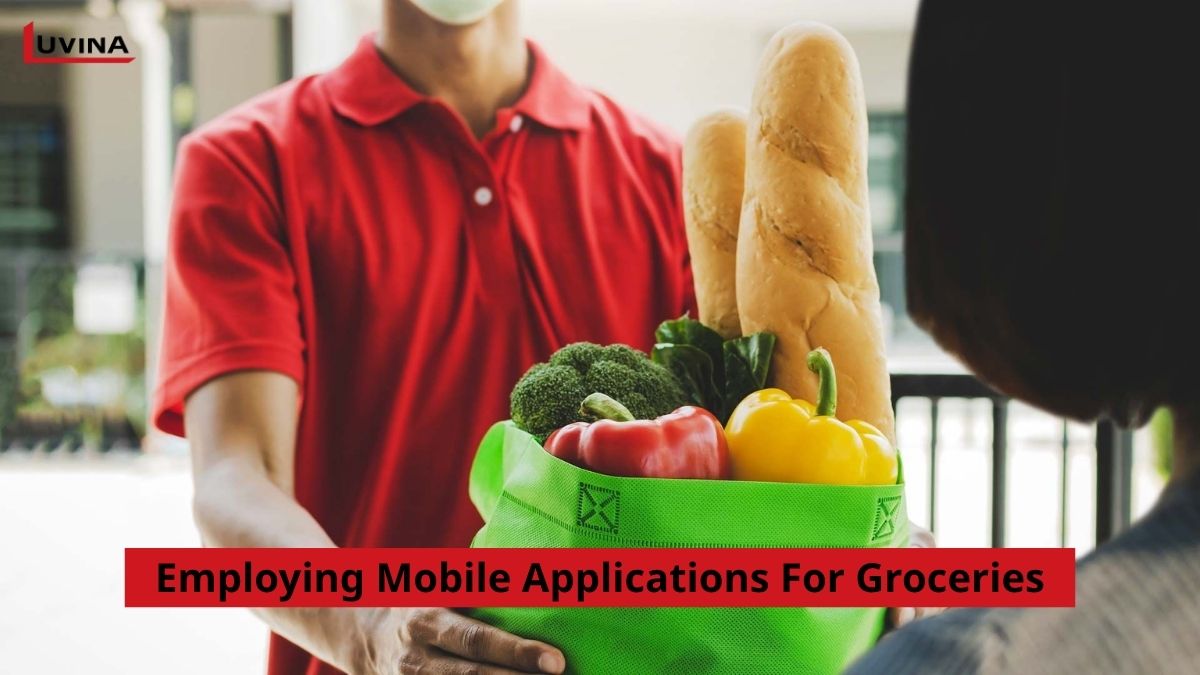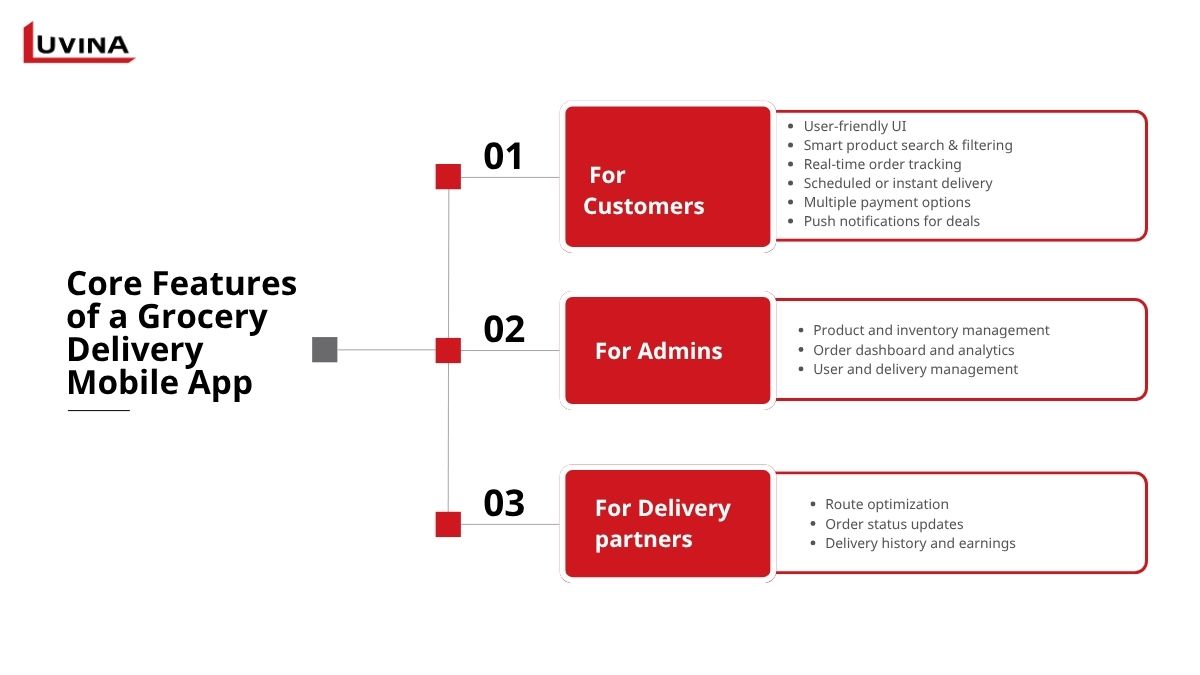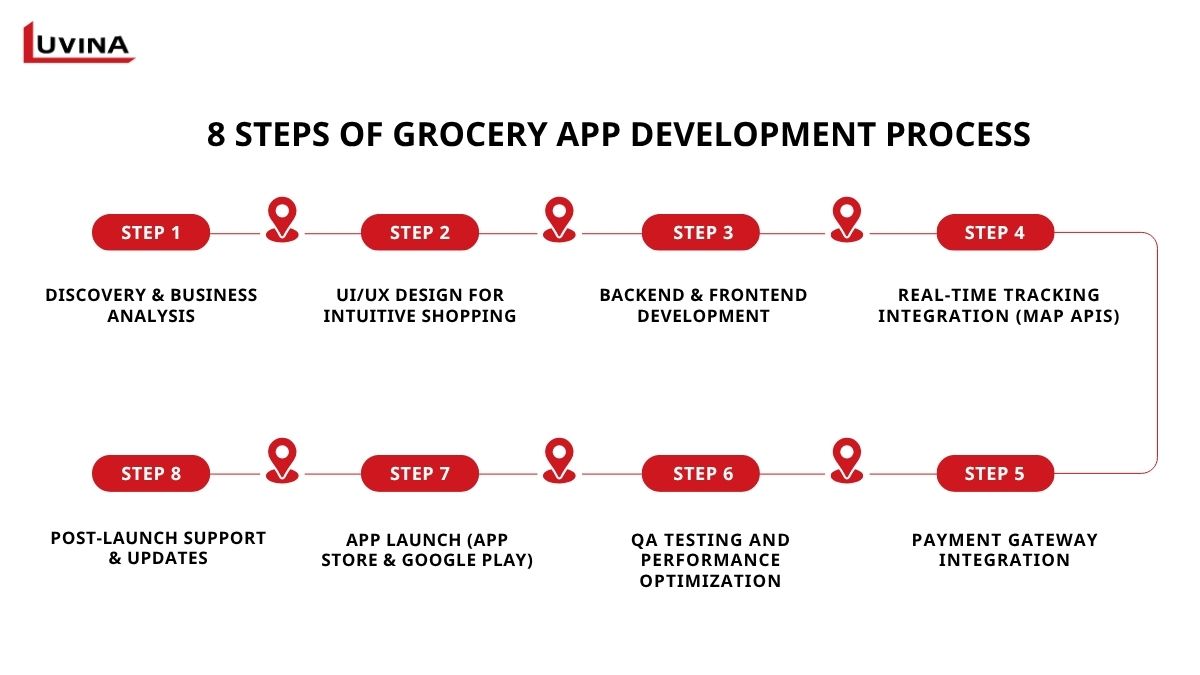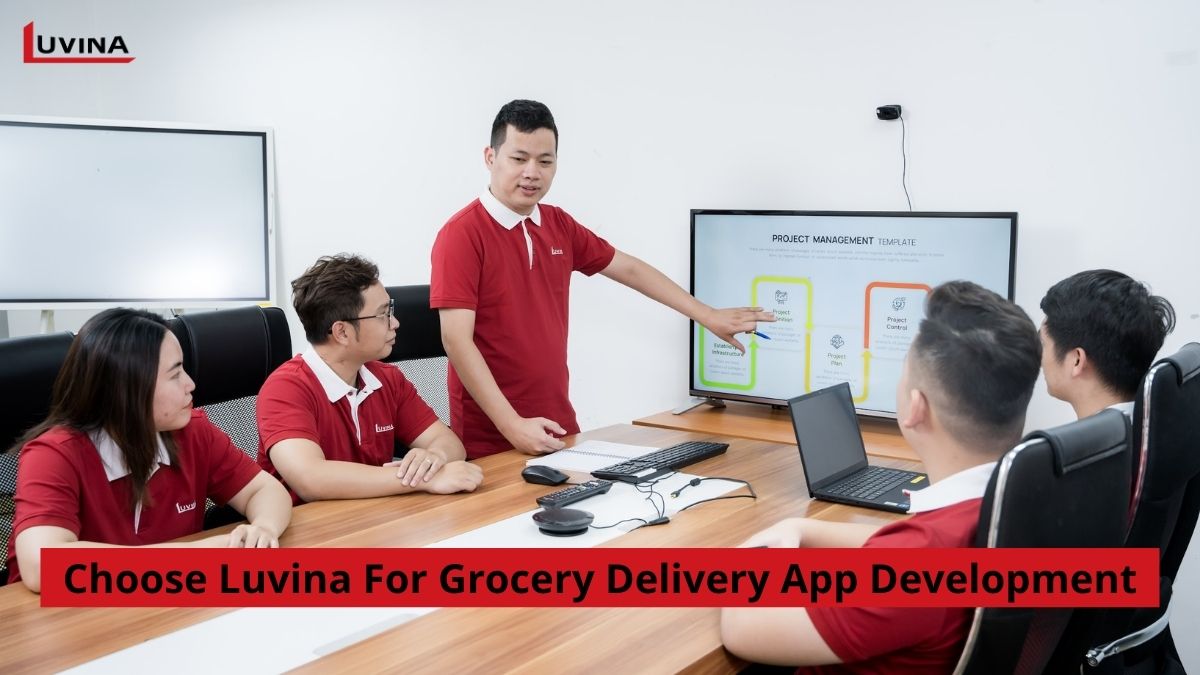Long confined to the realm of a few who could afford the ease of ordering deliveries from the web, online grocery has become a need for millions, including during the past few months, where the COVID-19 pandemic forced more consumers online, turning “rapid adoption” into an understatement. Recent estimates predict the e-commerce grocery industry could still be worth more than $800billion by 2025, so the trend won’t be going away any time soon.
Understanding grocery shopping app development is required if you wish to access this rapidly expanding sector. This thorough manual will lead you through the ascent of on-demand services, evolving customer expectations, and important features and procedures you will need to create a popular grocery app that encourages repeat use.
Why Now Is the Right Time to Build an On-Demand Grocery Delivery App?
The change in daily necessities purchase toward instant, mobile-first shopping has changed our habits, and this trend is only gaining momentum. Statista says the worldwide online grocery sector, worth around $286 billion in 2021, is expected to grow at a CAGR of over 15% to exceed $1 trillion by 2027.

This expanding market offers businesses the perfect window to invest in grocery shopping app development. Driven by the promise of speed, ease, and a flawless shopping experience, more than 39% of consumers already favor employing mobile applications for their groceries. The need for contactless, doorstep delivery is here to stay as life gets busier, therefore driving demand even further for well-created, user-friendly grocery apps.
Thinking about grocery application development as a strategic move to access this expanding market and ensure long-term customer loyalty right now is especially appropriate.
What Is Grocery Delivery App Development?
The new normal has now shifted to a few taps on an app, and groceries can be delivered to your front door. But what does grocery delivery application development take? In short, grocery delivery application development is creating, developing, and deploying an online platform that allows customers to order groceries online, providing access to shop in virtual aisles, make secure payments, and offer real-time delivery tracking for customers.
Unlike most other e-commerce platforms that sell a variety of products or restaurant delivery apps that focus on cooked meals, a grocery app serves a limited range of categories such as fresh produce, meat, dairy, and staples, which frequently demands strong inventory management and, in some cases, same-day or instant delivery service.
Grocery shopping app development is being considered by businesses of all sizes. It’s how the local grocery store gets to more neighborhoods. Big grocery chains use it to increase customer loyalty and to remain competitive. Startups and aggregator platforms are offering multiple vendors in one single app.
To launch quickly and grow easily, it’s important to focus on building the most important features first. Using simple, reusable parts when creating the app helps speed up development and makes it easier to add new features later. Planning for growth from the beginning also ensures the app works well even when many users start using it.
Core Features of a Grocery Delivery Mobile App
A high-performing grocery shopping app development means balancing convenience for users, smart tools for admins, and practical functions for delivery partners. Here’s what you need for a successful on-demand grocery delivery app development:

For Customers:
- – User-friendly UI: Clean design and easy navigation, helps people find what they want in less than a second
- – Smart product search & filtering: Advanced search and filters make it simple to quickly locate certain items.
- – Real-time order tracking: Live order tracking lets consumers track their orders in real time, therefore reducing post-checkout ambiguity.
- – Scheduled or instant delivery: People can schedule or get immediate delivery depending on convenience.
- – Multiple payment options: Regardless of card, e-wallets, net, or cash, make sure the checkout stays fast.
- – Push notifications for deals: Timely push notifications for promotions and discounts encourage repeat orders.
For Admins:
- – Product and inventory management: Real-time simple updates of product catalogs, stock levels, and categories via product and inventory management.
- – Order dashboard and analytics: Track orders, check delivery status, and get company insights to help you make informed decisions using the order dashboard and statistics.
- – User and delivery management: Assign deliveries efficiently and manage customer and delivery partner data in one place.
For Delivery partners:
- – Route optimization: Offers the best delivery routes to reduce time and fuel costs.
- – Order status updates: Allows drivers to move around while accepting and/or rejecting orders.
- – Delivery history and earnings: Drivers can view past deliveries and track their earnings anytime.
Our Grocery App Development Process
A clear process is what turns a promising idea into a successful product. At Luvina – an experienced grocery delivery app development company, we follow a step-by-step approach that covers every detail, from market research to launch and beyond. Here’s how a robust grocery shopping app development project should start and evolve.

1. Discovery & business analysis
This first phase requires you to think about what your app will bring to the picture, and how it might be different. First, start to evaluate the marketplace, your competitors, and their opportunities. Examine existing successful brands like Instacart or Walmart. Take notes of what worked and what did not.
Then look at customer insights as to who they are, what they need, and how they buy. Your fundamental value proposition, user journeys, and key characteristics can be mapped out using these results. The aim is to create a powerful idea with defined priorities and practical applications.
2. UI/UX design for intuitive shopping
Once your company plan is set, it’s now time to visually execute it. Your grocery shopping app development can either succeed or fail on great design, so you need a careful, user-first strategy. This is where seasoned grocery delivery app developers and designers collaborate to transform research results into a seamless, simple shopping experience.
Gather references first – that is, the interfaces or features you like (or want to avoid) – which help define your early product vision. Designers next compile moodboards using fonts, graphics, and colors that best reflect your app.
User trip mapping demands every tap, scroll, and step to be logical and obvious. This guarantees that consumers never get lost from browsing to checkout. The following come wireframes – simple, black-and-white sketches establishing the structure of the app to evaluate flow and usability.
Designers develop a polished idea and thorough prototypes once the flow is established to clearly illustrate how your supermarket app will appear and feel. Finally, a comprehensive design system and UI kit are ready to help your app remain consistent as it expands.
It’s wise to keep your feature list targeted at this point. Start with the most necessary items, then build as you discover what your clients love.
3. Backend & frontend development
A strong and effective technical base is at the center of any good grocery application development. Developers during this stage concentrate on creating an app that is secure, scalable, and high-performance, able to support all required grocery delivery operations. Building supermarket delivery apps uses several technologies, including:
Frontend development:
- – React Native: Enables cross-platform development, allowing one codebase to run on both iOS and Android.
- – Swift (iOS): For native iOS development and platform-specific optimizations.
- – Kotlin (Android): For native Android development, providing enhanced performance and integration.
Backend development:
- – Node.js: Manages orders, product administration, user authentication, and server-side logic.
- – Django: A Python framework noted for its quick development and straightforward, practical design.
- – MongoDB: NoSQL database that has a flexible way to store data and is tailored to various product catalogs.
- – PostgreSQL: A Stable relational database that processes complex queries about products and real-time inventory.
- – Firebase: Has real-time database and user management capabilities to help scale apps.
4. Real-time tracking integration (Map APIs)
Real-time tracking is a must-have feature for any successful grocery delivery app. By using dependable map APIs like Google Maps, users may view exactly where their orders are in real time and get exact expected arrival times. This transparency fosters trust and enhances the general user experience by minimizing ambiguity and constantly updating consumers.
Integrating notification services like Firebase or OneSignal also helps send directly to consumers’ devices on order status, delivery progress, and promotional deals.
5. Payment gateway integration
Using dependable and secure payment gateways prevents customers from abandoning their carts and allows them to your purchases in a fast and direct manner by utilizing a variety of payment methods. Credit and debit cards are the most common choices, but other options such as digital wallets (e.g., Apple Pay and Google Pay) or payment services (e.g., Stripe and PayPal) are popular as well.
Your app can offer a seamless checkout process while also securely handling customers’ sensitive information by offering multiple payment processing options with leading encryption standards.
>> Dig deeper: E-commerce Payment Gateway Integration: Complete Guide
6. QA testing and performance optimization
Following the design and development phases, thorough testing is important in grocery shopping app development. Testing should address all important aspects: functionality, performance under heavy traffic, security, usability, and cross-device and operating system compatibility. Enabling beta testers to replicate actual-world use exposes problems that might not come up in regulated settings.
In case of any MVP-oriented projects, have testing as a continuous effort. User feedback in the beta versions serves as valuable input to further improve the product, and developers gradually help to improve the stability and features.
7. App launch (App Store & Google Play)
Since we are a trusted grocery delivery app development company, we ensure your app consumes all of the platform requirements for the most natural and successful deployment.
The deployment procedure is constant. Every fresh version of your app will be submitted, evaluated, and released on these venues to provide your consumers with enhancements and new functionality.
Effective marketing becomes essential after launch to attract attention. Users are influenced by and can also acquire and retain themselves through social media campaigns, influencer partnerships, and referral programs. Even for the proper audience, paid search through Facebook Ads and Google Ads can lead to downloads of your on-demand food delivery app.
8. Post-launch support & updates
A good grocery shopping app development is a constant struggle that needs for perma supervision and enhancements to keep up with the competition.
- – Building a robust analytics system: Monitor user behavior, performance of your app, and the trends in the coming markets.
- – Collecting feedback from users often: Listen to customers and make support within reach to solve issues fast.
- – Scheduled updates: maintain a fresh app, boost customer engagement, and drive sales growth over time.
Remaining responsive to users and market requirements, your grocery delivery solution should always be kept up-to-date, user-friendly, and future-proof.
Why Choose Luvina as Your Grocery Delivery App Development Company?
Partnering with the correct team may mean all the difference in terms of grocery shopping app development. Ready to lead your project from first concept to continuing success, Luvina is a reliable leader in grocery application development.

More than 1,000 finished mobile projects benefit from our skilled designers and developers’ deep industry expertise and technical proficiency. We aim to provide user-centered designs that reduce the buying process and turn it into an intuitive and pleasurable one for consumers.
Our apps provide sophisticated capabilities, including fluent multi-payment options, AI-powered tailored suggestions, and real-time order tracking. Built on a strong, expandable foundation, they keep great performance even during periods of peak demand.
Each company has particular demands, we know. Luvina, therefore, provides fully customized solutions. Your app will be competitive and inventive thanks to our expert staff staying ahead of the newest trends and technologies.
Beyond growth, we vow ongoing aid and upgrades. Regularly modifying your app according to consumer input and market trends enables us to assist you in remaining relevant in the quickly changing grocery sector.
Selecting Luvina means selecting a committed partner concentrating on creating excellent, feature-rich supermarket apps that spur expansion and client happiness.
>> See more: PWA Development for E-commerce
Conclusion
As the demand for convenient, fast, and trustworthy grocery delivery services keeps growing, grocery shopping app development helps storekeepers to optimise their operations, reach more customers, and retain them for the long term. Smart technology integration is the future of grocery retail, and there’s no time like the present for grabbing hold of that future.
Ready to launch your own grocery platform in just 6–8 weeks?
With Luvina’s proven delivery framework and scalable team, we help retailers go live fast, with zero compromise in UX or reliability. Let’s talk about your idea.
FAQ
Can you integrate my grocery app with a third-party delivery or logistics service?
You bet you may simplify order fulfillment and tracking by connecting your grocery app with third-party delivery or logistics companies.
Can I build a multilingual grocery app to support different regions?
Yes! You might create a multilingual grocery app to assist consumers from various areas and increase accessibility.
How much does it cost to build a grocery delivery app?
Depending on the number and sophistication of features desired, the cost to develop a grocery delivery app usually runs between $30,000 and $55,000.









Read More From Us?
Sign up for our newsletter
Read More From Us?
Sign up for our newsletter